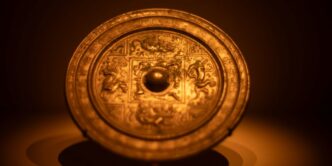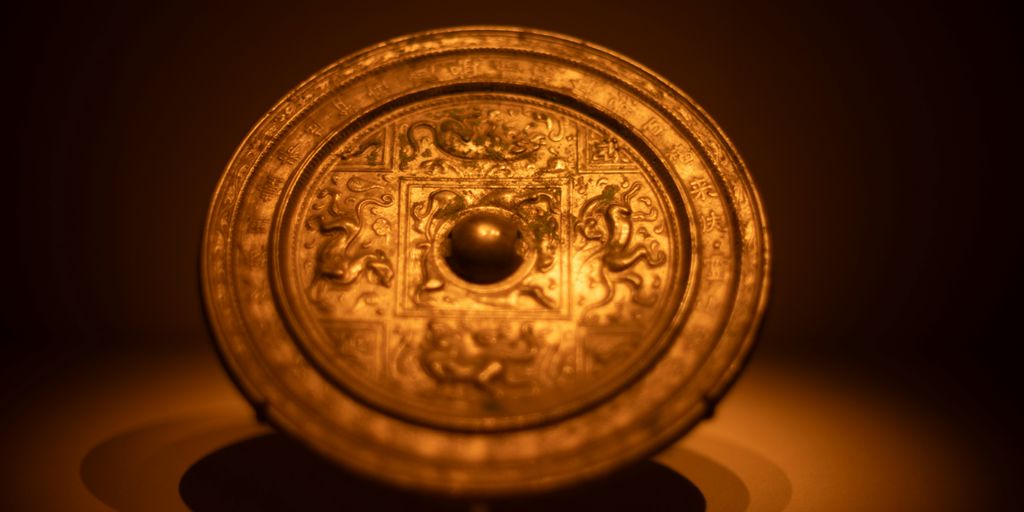We all love a good story, right? Well, some of the best stories come from myths and legends, and a big part of those tales are the amazing objects mentioned. These aren’t just random trinkets; they’re the kind of mythological objects that really drive the plot and make the legends what they are. Think about it – a magic sword, a powerful hammer, a ship that sails to adventure. These items are often central to the hero’s journey and the overall meaning of the myth. Let’s take a look at ten of these legendary mythological objects that have really stuck with us over time.
Key Takeaways
- Mythological objects are often more than just props; they are central to the narrative and symbolism of legends.
- From powerful weapons like Mjölnir and Excalibur to mystical artifacts like Aladdin’s Lamp, these items shape the destinies of heroes and entire cultures.
- The stories surrounding these mythological objects explore themes of power, destiny, good versus evil, and the human condition.
- Many of these legendary items have roots in ancient cultures and continue to influence modern storytelling and popular culture.
- Understanding these mythological objects gives us insight into the values and beliefs of the societies that created them.
1. Mjölnir

So, let’s talk about Mjölnir. This isn’t just any old hammer; it’s Thor’s hammer from Norse mythology, and it’s a pretty big deal. Crafted by dwarves, it’s known for being incredibly powerful and, get this, it always comes back when you throw it. Seriously, imagine never losing your hammer. It’s also said to be able to level mountains, which is, you know, handy.
What’s really interesting is how it came to be. Loki, being Loki, apparently made a bet with some dwarf brothers, Brokkr and Sindri. He bet his head that they couldn’t create anything as good as their rivals. Well, they made Mjölnir, and it was so impressive that Loki lost his bet, though he managed to wriggle out of giving up his head. Classic Loki move, right?
- It can control thunder and lightning.
- It’s incredibly durable, almost unbreakable.
- It returns to Thor’s hand after being thrown.
There’s even a story where Thor loses Mjölnir to a giant named Thrym. Thor had to pull off a pretty wild plan, dressing up as a bride to get it back. It just goes to show how important this legendary hammer was to him. It wasn’t just a weapon; it was a symbol of his power and protection.
2. Excalibur
Ah, Excalibur. You can’t really talk about King Arthur without mentioning this sword, can you? It’s one of those legendary items that just screams ‘king.’ The stories about where it came from are a bit mixed, which honestly just makes it more interesting. Some tales say Arthur pulled it from a stone, proving he was the rightful ruler of Britain. That’s a pretty dramatic way to get a crown, I have to say. Other versions have the Lady of the Lake, a mysterious figure, gifting it to him after he was already king. Either way, it was clearly a big deal.
What’s really cool is that Excalibur wasn’t just for show. It was said to have some serious magical properties. The blade itself could apparently shine like thirty torches, blinding enemies in battle. And get this, the scabbard, the thing you put the sword in, was supposed to stop Arthur from bleeding. Imagine that! It really cemented his image as a powerful and almost invincible leader. It’s a symbol of his right to rule, and honestly, who wouldn’t want a sword that makes you shine like a beacon and keeps you from getting hurt? It’s no wonder this sword is so famous; it’s tied to the very idea of Arthur’s legitimacy and his reign. You can find mentions of Arthur’s sword in early texts, but it was later writers like Thomas Malory who really gave us the name Excalibur, solidifying its place in Arthurian legend.
3. Aladdin’s Lamp
You know, the story of Aladdin’s Lamp is one of those tales that just sticks with you. It’s not just about a guy finding a lamp and getting wishes; it’s about how power can change a person, for better or worse. The lamp itself, an unassuming oil lamp, is the key. When rubbed, it summons a genie, or rather, two genies – a lesser one and a greater one. These aren’t just wish-granting machines; they are bound to the lamp’s owner, obligated to do their bidding.
The real magic isn’t just the wishes, but the responsibility that comes with them. Aladdin’s journey shows this. He uses the genies to become rich and powerful, which is pretty standard wish-fulfillment stuff. But he also has to deal with an evil sorcerer who wants the lamp for himself. It’s a classic good versus evil scenario, with the lamp as the ultimate prize.
It’s interesting to think about the origins, too. Some people think the story might be based on a real person, a storyteller named Hanna Diyab. He apparently found a lamp himself while treasure hunting, which sounds like something straight out of a fairy tale. It makes you wonder how many of these old stories have a kernel of truth buried somewhere inside them. It’s a good reminder that even the most fantastical objects can have roots in reality, and that the desire for power and the struggle against evil are pretty timeless themes.
4. Armor of Achilles
You know, when you think about the Trojan War, one name that always pops up is Achilles. And a huge part of his legend is his incredible armor. This wasn’t just any old getup; it was crafted by Hephaestus himself, the god of the forge. Imagine that kind of divine craftsmanship! It was said to be practically unbreakable, a real game-changer on the battlefield.
The most famous piece was probably his shield, described as a masterpiece of metalwork, depicting scenes of life, war, and the cosmos. It’s wild to think about the detail that went into something like that, even if it was just a story.
But here’s the kicker, right? Even with all that protection, it couldn’t save him. The whole Achilles’ heel thing is legendary for a reason. It’s a stark reminder that even the mightiest can have a vulnerability. After Achilles died, there was a whole drama about who deserved his armor, with Odysseus eventually getting it. That whole situation led to Ajax going off the deep end, which is pretty grim.
It’s fascinating how this armor, meant to make him invincible, ultimately became a symbol of his tragic fate. It really makes you think about what true protection even means. You can read more about the legendary Achilles and his story.
5. Golden Fleece
You know, the Golden Fleece is one of those legendary items that just screams adventure. It’s the wool from a magical, flying ram, and its story is a big deal in Greek mythology. The whole quest for it is pretty famous, mostly because of Jason and his Argonauts. They had to go through all sorts of trials to get it.
So, the ram itself was pretty special, a son of Poseidon, the sea god. After the ram died, its golden fleece was hung up on an oak tree in a special grove. Now, for Jason to become the king he was supposed to be, he had to go get this fleece. It wasn’t exactly an easy task, though. The fleece was guarded by a dragon that apparently never slept. Luckily for Jason, he had help from Medea, a witch who gave him a sleeping potion for the dragon. It’s a classic tale of bravery, betrayal, and a whole lot of travel. The Golden Fleece is often seen as a symbol of achieving a difficult goal or proving one’s worth. It’s the kind of thing that makes you think about what you’d go through to get something truly important, like proving your claim to authority.
6. Apollo’s Bow
When you think of Greek gods, Apollo often comes to mind as the god of music, poetry, and light. But he was also a pretty serious archer, and his bow was no joke. This wasn’t just any old bow; it was a finely crafted instrument of divine power.
Crafted by the master blacksmith Hephaestus, Apollo’s bow was given to him for a very specific, and dangerous, purpose. His mother, Leto, was being hunted by the monstrous serpent Python, a creature sent by the jealous goddess Hera. Apollo, armed with his new bow, tracked down Python near the Castalian Spring in Delphi. He successfully killed the serpent, saving his mother’s life. This act, however, put him at odds with Gaia, Python’s mother.
Apollo’s bow wasn’t just for slaying monsters, though. It was a symbol of his authority and his ability to strike from afar, whether it was to bring plague or healing, depending on his mood. It’s a reminder that even the gods had their tools of power, and Apollo’s bow was definitely one of the most significant.
7. Pandora’s Box
Okay, so let’s talk about Pandora’s Box. You know, the one that supposedly let all the bad stuff out into the world? It’s a pretty famous story, but here’s a little detail: it wasn’t actually a box. Most accounts say it was a big jar, or a ‘pithos’ in Greek. Zeus, the big boss of the gods, apparently gave this jar to Pandora, who was the very first woman. She was created as a sort of punishment for humanity after Prometheus stole fire from the gods. So, Pandora shows up with this jar, and guess what? She opens it. And out flew all the evils that plague us today: sickness, sorrow, greed, all that fun stuff. The only thing left inside when she managed to close it was Hope. Some versions say she opened it out of pure curiosity, which, honestly, feels pretty relatable. It’s a powerful symbol, isn’t it? That moment when you do something, maybe without thinking, and suddenly everything changes for the worse. It’s a reminder that even with the best intentions, some actions can have really big, unintended consequences. It’s a story that’s stuck around for ages, showing up in art and literature, and even influencing how we talk about problems today – like saying ‘opening Pandora’s box’ when something goes wrong.
8. The Holy Grail
You know, the Holy Grail. It’s one of those things everyone’s heard of, right? It pops up in all sorts of stories, especially the King Arthur ones. Basically, it’s often talked about as the cup that Jesus used during the Last Supper. Some tales even say it was used to collect his blood when he was crucified. That’s pretty heavy stuff.
Then there are the Arthurian legends where it’s this amazing cup or bowl belonging to a wounded king, the Fisher King. Or, it’s this lost treasure that Arthur’s knights go on a big quest to find. Sir Galahad, you know, the really pure knight? He’s the one who usually manages to find it in a lot of the stories, which makes sense given his whole deal. It’s become this symbol for something people are searching for, something really important and hard to get. It’s funny how something so central to a legend can have so many different versions of its origin and appearance.
9. Ruyi Jingu Bang
You might know this one from Journey to the West, the classic Chinese novel. It’s called the Ruyi Jingu Bang, which basically means "As You Wish" staff. This thing is wild because it can change its size. Like, seriously, Sun Wukong, the Monkey King, could shrink it down so small it fit behind his ear. But when he needed it, it could grow to be absolutely massive, like a pillar. He got it from an underwater dragon palace where it was actually holding up the roof of the palace. The dragon king let him have it, but only if he could lift it, which, of course, the Monkey King did. It’s a pretty handy tool for a guy who gets into as much trouble as he does.
10. Argo

When you think of legendary journeys, the Argo has to be right up there. This wasn’t just any old boat; it was the vessel that carried Jason and his crew, the Argonauts, on their epic quest for the Golden Fleece. Imagine the scene: a ship built by Argus, with a special piece of wood from the sacred forest of Dodona right in its prow. This bit of timber was no ordinary wood; it could actually talk and give prophecies! Pretty wild, huh?
So, what made the Argo so special?
- The Talking Prow: As mentioned, a piece of Dodona oak in the ship’s bow could speak and offer predictions. This was a huge advantage for Jason and his crew, guiding them through their perilous journey.
- A Star-Bound Legacy: After the Argonauts successfully retrieved the Golden Fleece, the Argo didn’t just get retired; it was transformed into a constellation. Talk about a lasting tribute!
- Famous Passengers: It wasn’t just Jason. The legendary strongman Heracles was also aboard, adding to the ship’s impressive roster of heroes.
The Argo’s journey was more than just a voyage; it was a defining moment in Greek mythology, a story of courage, destiny, and a ship that became immortalized in the stars.
The Echoes of Legend
So, we’ve looked at some pretty amazing things from stories told long ago. From weapons that could change size to ships that could see the future, these objects really stick with you. They show us how people thought about power, destiny, and even hope. It’s wild to think about how these myths, and the items within them, have been passed down and still capture our imagination today. They’re more than just old tales; they’re a big part of what makes us human, always looking for something extraordinary.
Frequently Asked Questions
What exactly are these mythological objects?
These are amazing items from old stories and myths. Think of them as powerful tools or symbols that characters in legends used. Some are weapons, like Thor’s hammer, while others are magical objects, like Aladdin’s lamp.
Where do these stories and objects come from?
These objects come from all sorts of old tales from different cultures. For example, Mjölnir is from Norse myths, Excalibur is from British legends, and Aladdin’s Lamp is from Arabian stories.
What kind of powers do these items have?
Many of these items are said to have special powers. Mjölnir can control lightning, Excalibur grants great power, and Aladdin’s Lamp can summon a genie who grants wishes. They are often key to the hero’s success.
Are these objects linked to specific heroes?
Yes, many of these objects are connected to famous heroes. Thor wields Mjölnir, King Arthur has Excalibur, and Jason sailed on the Argo. These items often define the heroes who use them.
Are these objects real?
While these are amazing stories, it’s important to remember they are legends. They come from myths and folklore, not from real historical events. We enjoy them for the exciting tales they tell.
Why are these legendary items so important in stories?
These objects are important because they help tell the story. They often represent courage, destiny, or the struggle between good and evil. They make the legends more exciting and memorable.



![a person holding a [UNK] [UNK] game [UNK]](https://techannouncer.com/wp-content/uploads/2025/08/20096621thumbnail-332x166.jpeg)
![a person holding a [UNK] [UNK] game [UNK]](https://techannouncer.com/wp-content/uploads/2025/08/20096621thumbnail-688x387.jpeg)







